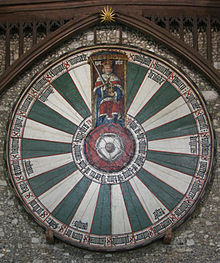Round table

The idea of a round table (French table ronde , English round table , see round table Welsh "Bwrdd Arthur") was first introduced by the Anglo-Norman poet Wace (around 1150) in the story of King Arthur (English name version mostly Arthur ) . Arthur invented the round table so that there would be no disputes about the best seats.
Participants at the round table
In the following centuries, in the popular narrative genre of the Arthurian novel in the various Western European literatures ( Old French , Middle High German , Middle English ), the idea of the round table became a fixed element of the Arthurian legend. The number of its members was not limited (French texts of the 13th century speak of 150, 240 or 366, Layamon's "brood" of 1600 knights). In modern times, a more selective idea prevailed: according to John Dryden , King Arthur's round table numbered twelve, while according to Sir Walter Scott , sixteen knights , who perfectly embody the ethic of chivalry . Medieval literature therefore has no fixed ranks of members of the Round Table. Rather, the “most important” and “best” (i.e. the knights who play an important role in the present novel) were always considered to be members of the round table.
This included in all stories:
- Gawain (Gawan),
- Lancelot ,
- Parceval (Parzival),
- Tristan (Tristam),
- Galahad ,
- Keie (Cei fab Cynyr),
- Iwein (Yvain),
- Mordred and
- Bors .
Furthermore, often also
- Erec
- Gareth (also called Beaumain, the kitchen knight)
- Agravane
- United fab heiress
- Peredur fab Efrawg
- Gwrhyr Gwalstawd Ieithoedd
- Lamorak
- Palamedes
associated with the Round Table.
Other people sometimes mentioned are:
- Sir Aglovale , son of King Pellinore of Listinoise
- King Bagdemagus
- Sir Bedivere (Bedwyr)
- Sir Breunor , also "La Côté Mal Taillée"
- Sir Cador
- Sir Caradoc , called "Caradoc Vreichvras", or "Caradoc Strong Arm"
- Sir Colgrevance
- King Coel
- Sir Constantine , son of Cador, became king after Arthur's death
- Sir Dagonet , jester
- Sir Daniel
- Sir Dinadan , son of Sir Brunors Sr. and brother of Sir Brunors le Noir "La Côté Mal Taillée"
- Sir Ector , Arthur's foster father and Sir Keie's father
- Sir Ector de Maris , son of King Ban of Benwick
- Sir Elyan the White , son of Sir Bor
- Sir Gaheris
- Sir Galeshin (son of Elaine and King Nentres)
- Sir Gingalain , initially called Sir Le Bel Inconnu Gawain's son
- Sir Griflet , also Sir Griflet le Fils de Dieu
- Hoyer the Red, is in Wigalois mentioned
- King Leodegrance , father of Guinea , servant of the Round Table
- Sir Lionel
- Sir Lucan
- March fab Meirchiawn
- Sir Meleagant ,
- Sir Meliant de Lis
- Sir Morholt
- Sir Pelleas , consort of the Lady of the Lake
- King Pellinore
- Sir Sagramore le Desirous
- Sir Safir , Palamedes' brother
- Sir Segwarides , Palamedes' brother
- Sir gate
- Owein fab Urien
- Sir Ywain (Owain), son of King Uriens of Gore
- Sir Ywain the Bastard , also Urien's son
In Winchester , a round table is still on display today, which for centuries was considered the authentic round table. It has 24 places marked with names. In the so-called Garel room in Runkelstein Castle near Bozen , the round table was depicted as a wall painting around 1390.
literature
- Thomas Malory : King Arthur. Transfer v. H. Findeisen. Leipzig 1973.
- Karl Langosch : King Arthur and his round table. Reclam, Stuttgart 1980, ISBN 3-15-029945-4 .
- Pamela Ryan: A Dictionary of King Arthur's Knights . ISBN 1-877853-61-5 .
- B. Schmolke-Hasselmann: The Round Table: Ideal, Fiction, Reality . In: Arthurian Literature, II, 1982, pp. 411-475.
- C. Scott Littleton: From Scythia to Camelot: A Radical Reassessment of the Legends of King Arthur, the Knights of the Round Table, and the Holy Grail . ISBN 0-8153-3566-0 (outsider theory).
- Dictionnaire des mythes littéraires , sous la direction de Pierre Brunel , Éditions du Rocher, 1998. Notamment l'article de Jean-Louis Backes “Le Graal”, p. 675–687 et celui de Pierre-François Kaempf, “Parsifal”, p. 1150-1154.
- Jean-Jacques Vincensini: Pensée mythique et narrations médiévales. Paris, Champion, 1996.
Web links
- Representation of the round table (around 1390) at Runkelstein Castle
Individual evidence
- ^ Renate Seidel: The Counts of Mansfeld - history and stories of a German noble family. Fouqué Literaturverlag, Engelsbach 1998, p. 85, ISBN 3826742303 .
